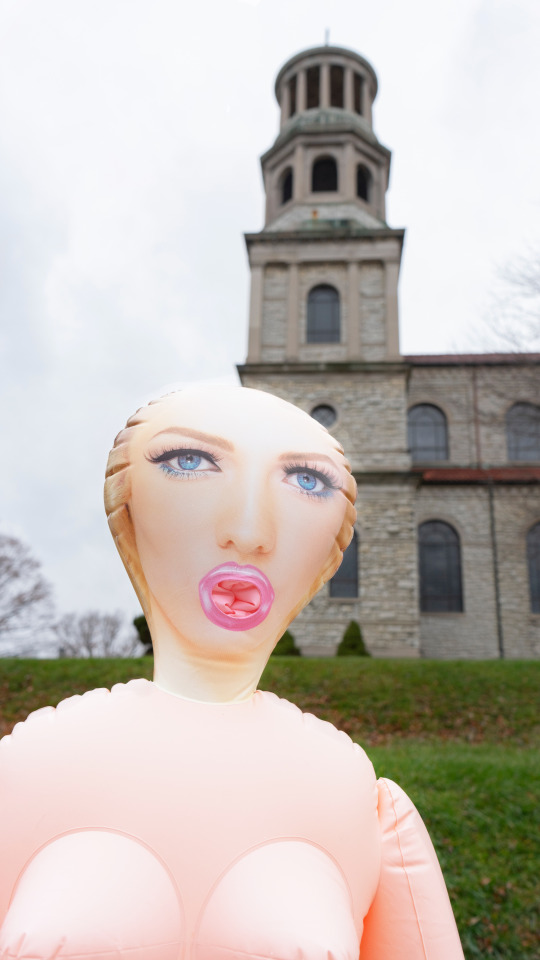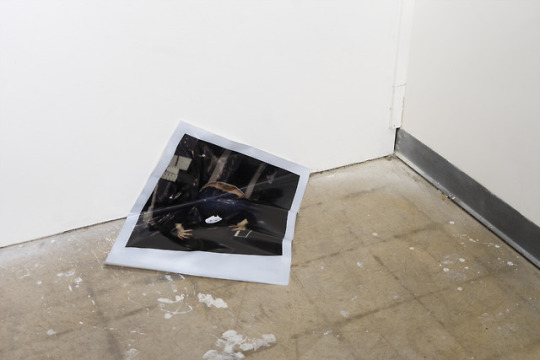#daapmfa
Text
Pl34SUR3S
While working, I chose not to intervene with Christian institutions in lower-income or underprivileged areas. A lot of learning has resulted from this project as it has been conducted. Out of that knowledge, I’ve generated newfound respect; not just of people’s faith, but of the community that surrounds these institutions and its function as a still-beating-heart within Cincinnatian gentrification. Out of respect, I set one hard restriction within the parameters of this project.
Goal: Discussion and action towards sex education reform in public schools by challenging one of its biggest stakeholders, religion.
Topic: Sex Censorship
Audience: Institutions and congregations of the Christian faith (primarily in well-functioning districts)
Disruption: Public Art/ Performance and documentation of blow-up doll No.2 (Betty) juxtaposed with religious institutions
By investigating how religion, Catholicism, in particular, has cultivated an air of taboo around sex, this project urges its faculties to reconsider their quasi-archaic conventions through public art disruption and discourse. The end goal of this project is to advocate for sexual education reform in public schools through the implementation of a blow-up doll. This project proposes that if you can have a dialogue about sex in church congregations, then it shouldn’t be unreasonable to have the same dialogue in schools; opening up discussion more freely and unburdening awkwardness.

This project comes down to the fundamental battle and restraints that pro creationism has perpetrated over the years and how institutions such as the Vatican, prevent progressive social reform from ever being discussed; preventing access by censoring or ignoring the topic through various loopholes/misdirection. For instance, catholic families can omit their children from participating in sex-ed classes entirely by writing a note.
On Catholicism and Religion & History
It’s a widely accepted faith with a lot of history and influence. So, when we think of the very beginnings of civilization, procreation was necessary for safety in numbers, working offspring, food gathering, and innovation. Since language was invented, procreation as been one of the binding values that belief systems, governments, and institutions all share.

Catholicism used it as a way to create more followers (I mean this in a sincere way) and keep family members united; which is a good thing…until you get to the 21st century. “In the past decade alone, online dating has had probably the biggest single impact on our sexual lives. Websites and apps designed to facilitate sex and romance are everywhere”. This isn’t to say that Catholicism is inherently bad; in fact, it’s done a lot of good: inspiring goodwill, charity, faith, and rules that keep people from harming others. The problem with the way that religion perpetrates procreation now is that any partner-seeking individual within a congregation is expected to keep up with orthodox. The unfortunate, but true fact is that many members of the Catholic faith don’t follow these restrictions. Forced into secrecy, this then creates even more problems. Catholic women are 5X more likely to have an abortion in unsanitary conditions, often resulting in permanent damage to their reproductive organs.
By implementing a blow-up doll, I was able to stage a disruption that facilitated immediate dialogue. I armed myself with facts, statistics, and my mantra-my reason for interrupting their form of seeing-“IF you can talk about sex in church, then you can talk about sex in schools”, which was my way of simplifying advocacy for sex-education reform in public schools. What I’m advocating for in particular is more transparency and access to intermittent sex-ed courses and the inclusion of gender and sexuality studies. Sex-education is treated as a one-and-done course; with the majority of public schools only making it mandatory for a quarter portion of school year studies. Sex-education should be taught repeatedly and intermittently. Teenage and adolescent bodies change drastically throughout cursory education. These physical and emotional changes should be addressed chronologically in tangent with lessons on sexuality and gender; garnering an understanding of attraction, cross-gender, and sexual preference, would generate acceptance of the self and surrounding classmates. This would generate lifelong learning and positive habits for understanding diversity both in school and in alternative environments.
Why a Blow-up Doll?
I chose a blow-up doll for this project because of these points which ascribe its relevance and activation as a device for disruption in this case :
Blow-up dolls were popularized by men and have a historical prevalence of sex. Primordial versions date as far back as Greek Mythology: The story of Pygmalion which was eventually turned into a play by George Bernard Shaw [of the same name].

Females are heavily scrutinized and overlooked in the Bible. In fact, Wikipedia’s list of biblical female names used in the Bible says “This list contains persons named in the Bible of minor notability, about whom either nothing or very little is known, aside from any family connections.”Blow dolls throughout history consistently depict a female form [which is what I am]Contemporary, radical feminism has been facilitated by females and the female form has been viewed as a vessel for change; which I think authenticates its existence. Many of today’s hot debates are centered around female rights, pro-choice, women’s health, etc., all of which Catholicism plays a major stakeholder in and against. (This reason most of all, I enjoy because it forces femininity into the banal foreground; gloriously nude and proud). It’s symbolic of modernity, change, and acceptance. Finally, blow-up dolls are hilarious and brutally forward. They are indexical of sex in private quarters, but questionable in public forum. Something as puzzling as a ‘rogue blow-up doll’ incites query automatically.
In Action: The Disruption
youtube
First attempts at launching Blow-up doll worked in provisional trials but not by simply filling the doll with helium [blow-up dolls made from PVC cannot simply be filled with helium and float. Buoyancy rates when using helium rise and fall according to the material and surface area]. I had to resort to using multiple balloons, fishing wire, stock helium, and strategic timing which made the project far more foreign when just starting out. Using the balloons and floating a blow-up doll A) happens far too quickly to time intervention with congregation B) requires a larger strike force of people that I didn’t have C) Any rogue wind would result in misdirection of the doll and instigate a search and rescue mission. Floating the doll was canceled after rogue winds caused the doll to come in contact with the steeple of the church; popping balloons and dislodging harness from doll resulting in minor panic from bystanders [and also getting chased off church property]. The doll hit the cross adornment at the top of the steeple of the church and fell, as made barely visible in the photograph.

Parameters
A lot of learning has resulted from this project as it has been conducted. Out of that knowledge, I’ve generated newfound respect; not just of people’s faith, but of the community that surrounds these institutions and its function as a still-beating-heart within Cincinnatian gentrification. Out of respect, I set one hard restriction within the parameters of this project. While working, I chose not to intervene with Christian institutions in lower-income or underprivileged areas. Out of respect for the community, I chose not to intervene with these buildings because of their role in lower-income areas as not only a place of worship, but a place for community gatherings, faith, outreach, charity, and goodwill. Many of these areas don’t have places for community outreach except for places of worship. Latoya Ruber Frasier’s work calls for awareness of gentrification in the Braddock area of Pittsburgh. Similarly, she notes that factions of a dilapidated community infrastructure often cling to a building, area, or meeting place that serves as the community’s only existing place of refuge. In the series, Campaign for Braddock Hospital (Save Our Community Hospital) (2011), Frazier curates a series of photographs with written recountments and repurposed advertisements from competing industrial investors; those who were wanting to purchase the hospital. This series shows the hopeless, last stand of a community fighting for the essence of their existence to remain intact. Intervening in these areas with this disruption practice would make people less likely to talk or even feel motivated to discuss sex-ed reform. I wanted people to be able to laugh at the end of conversations; not feel disenfranchised, violated, or looked down upon more. All of these concerns tie in with the “Stranger with a Camera” screening which discussed how an outsider’s objective of intervening within an environment can potentially belittle it further and put the outsider in a dangerous position.

Intervention/Disruption
Once the blow-up doll was in position, people came to me quickly. Initial rage was common amongst the conversations I had. Typically, people were outraged and would begin conversations by questioning who was responsible. In the Videos presented in class, every incident is represented/documented by an intervening photographer. Specifically, I think that the work intervenes on a level that could be considered risky’. Not only is it an intervention of visual culture, but it has the potential to disrupt critical cultural values in a specified area or group. For these interventions, caution is a must, but also the consideration of values that are being devalued. Interestingly enough, most of these people never actually saw me placing the doll in position. They were making assumptions based on prejudice; unrealistic expectations to lead them to the perpetrator of the incident or placing blame on me automatically based on proximity and associative stigma. This is where another reading comes into play. Karen Strassler, Refracted Visions, photographer as a ‘witness to history’ and the expectations of photographers as inherent record keepers. Where this intervention documents a specific disruption, the members of the congregation wish to omit this type of history from ever taking place.
Interviews
Once Initial reactions transpired and commonalities exchanged, I had questions I would give:
-Can you explain why this makes you upset?
-Why isn’t sex talked about in church and why do people pull their children out of sexed classes in school? Do you think this is beneficial to them in the long run, why/why not?
-If sex-ed was reformed, would you allow your children to attend?
-What do you think about the dismissal and coverups of sexual predators within the institution?
-Do you see similarities between priest defilement and sex aversion in Catholicism? If yes, what needs to change? If no, are you aware of either issue?
-I miss participating in Catholic ceremonies, mass, and the sacraments, but I feel that the infrastructure is wildly corrupt. The priest I grew up listening to for 18 years was accused of sexual assault. I now consider myself a pansexual. How could I ever return to this faith and why aren’t many of these men serving crime in person?
-Do you agree with sex-ed reform in public schools to include more, intermittent classwork and development? Would you condone gender and sexuality studies in this class?
-Do you think the Catholic Church will ever consider reformation for the inclusion of more progressive practices, inclusion, and accommodations that meet modern advancements?
Works Cited
Frazier, Latoya Ruby. Campaign for Braddock Hospital . Pittsburgh, 2011.
Garland-Thomson, Rosemarie. Staring: How We Look. Oxford University Press, 2015.
“List of Women in the Bible.” Wikipedia, Wikimedia Foundation, 3 Dec. 2019, en.wikipedia.org/wiki/List_of_women_in_the_Bible.
Strassler, Karen. Refracted Visions: Popular Photography and National Modernity in Java. Duke Univ. Press, 2010.
#alyssamaurerphoto#alyssamaurer#alicegraphy#alicegraphyy#daapmfa#daap#criticalvisions#intervention#disruption#blowup
2 notes
·
View notes
Photo

Tender knots
Fascinated by the shape of you, I long to return to that place of warmth and solace. I yearn for the pulsating sweetness of your blood, like leaking honey, to set rhythms for my body to synchronize. I wish to recount all the tender knots you spun inside me over the years just below my diaphragm. Let me give them back twice over in splendid, chaotic disarray by filling up the vacancy I’ve built inside you.
Mixed Media Collage by Alyssa Maurer @alyssamaurerphoto & www.alyssamaurerphoto.com
#collageart#collageartists#alyssamaurerphoto#alyssamaurer#alicegraphy#alicegraphyy#artists on tumblr#artists of instagram#daapmfa#daap2020#dissection#cavitylove#the lovely bones#photography#photo of the day#photographers of instagram#photographers of tumblr
0 notes
Photo

"A Crack Inside a Crack Involving Crack", the original image is courtesy of my grandmother's photographs and the person is my uncle Don. Now, the story behind the title of this piece and the reason for its composition is a little family gem of hilarity. Don was leaving a Penn state football game at one point. For those of you who have never experienced the dreadful crowds of sports events, coming and going, it's a mess of tired, cranky people clambering to get back home. My mother and Don were walking when Don spotted a women across the road. She was bent over and displaying a half-moon directly towards their company. Seeing this as a comedic moment, he turned to my mother. "Hey Steph", he said while nodding towards the woman across the road, "Don't do crack". While this still remains a staple for laughter at family gatherings, I wanted to play on that and the irony of finding my uncle's picture and in a similarly compromising position that we all have grown to giggle at. Cheers Uncle Don and don't do crack.
Photo by Alyssa Maurer
Subject courtesy of Eve Coho’s personal photographic archive
#archive#alicegraphy#alicegraphyy#alyssamaurer#alyssamaurerphoto#installation#install#photosculpture#daap#daapmfa#daapsoa#studioart#photography#corner
0 notes
Photo

Freedom
#alyssamaurerphoto#alyssamaurer#alicegraphyy#alicegraphy#daapmfa#daapsoa#flowers#flower#photographersofig#photographers#photography#contemporaryphotography#contemporaryart
0 notes
Photo

Constriction
Concurrent MFA thesis and studio work. I think I’ve finally figured out what my thesis and body of work is centered around. I’m looking forward to the future finally.
#alyssamaurerphoto#alicegraphy#alicegraphyy#alyssamaurer#daap#daapsoa#daapmfa#flower#flowers#body image#bodywork#contemporaryphotography#photography
0 notes